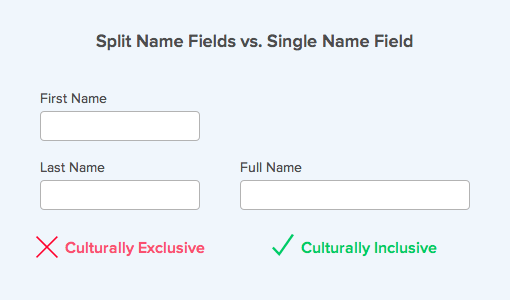“Full name” vs “First/Last name” UX Best Practice
One of the most basic inputs in every web application is the user’s name. The first question that pops up in the mind as a UX designer or Information Architect is whether to use “First name” and “Last name” or just “Full name”? If you are in the same situation and have the same question, follow this story.
This was not a question for years and developers tend to go for two separate fields as a habit.

But now we see many web applications are using only “Full name”.

So what should we do? The answer is as simple as “IT DEPENDS”
There are reasons why you shouldn’t use two separate fields and you better go for one filed. Internationalization is one of them. Antony from https://uxmovement.com describes it this way:
Not every user has a first and last name. Their cultural background determines how their name is formed. For example, if you’re from Latin America, the chances are that you have two last names, one from each parent. If you’re Chinese, your family name is first, personal name is last, and you always use them together.
If you are intended to serve people from around the world and want every user to be able to insert their name in their cultural structure, you may need to do what EMUI does on Andriod:

The structure of a name is not the same across cultures. Users who visit your site will consist of a broad range of people from different countries. Your name field should be culturally inclusive so that no one struggles to fill out your form. With most things in life, having two is better than one. But when it comes to name fields, having one is better than two.

Now consider this situation:
The marketing department needs to send emails to users to advertise new promotions. They think sending personalized emails is more effective. How they make it personalized? Simple, by putting the first name of the user at the top of the email saying “Dear {user’s first name}”. They like to use the first name to let users feel more friendly.
In this case, we need the first name to be separated. So maybe the separate fields work better in this case. This is why I said it depends.
So the best approach to figuring out whether it is better to use separate fields or one field is to think about the exact use cases in your application. Asking yourself these questions may help:
- Why we are asking users to give us their names (list the use cases)?
- (Now look at your list and ask) Is first name enough?
- Is last name enough?
- If not (need both of them), how we use it? Do we use it together or separately?
Answering these questions will give you the answer to design a better form.
In my personal experience, in enterprise web applications, I usually go for single full name, since in all use cases we just need to display user’s full name so I don’t bother user with two fields.
Bonus note
Some forms use a field named “Preferred name” or “How do we call you?” to solve the problem of the marketing department. Even though this approach might work in some scenarios and applications but should not be used as a general pattern. According to Steve Krug in “ Don’t Make Me Think” , best UX is the UX that doesn’t create questions in the user’s mind.

A form like this immediately pops up a question in the my mind “If I’m telling you what you should call me, why you’re asking for my full name? I like to be called as I’m saying!”. If you need my full name too, you need to explain why!

